Rheological, Thermal, and Degradation Properties of PLA/PPG Blends
Abstract
1. Introduction
2. Experimental
2.1. Materials
2.2. Preparation of PLA/PPG Composites
2.3. Characterization
2.4. Methodology
2.4.1. Determination of the Polymer Non-Newtonian Index
2.4.2. Determination of Polymer Degradation Rate by TORQUE Rheometry
3. Results and Discussion
3.1. Capillary Rheological Properties
3.2. Torque Rheological Properties and Degradation of the PLA and PLA/PPG Composites
3.3. Thermal Properties
3.4. Micro-Morphology
4. Conclusions
Author Contributions
Funding
Conflicts of Interest
References
- Geyer, R.; Jambeck, J.R.; Law, K.L. Production, use, and fate of all plastics ever made. Sci. Adv. 2017, 3, e1700782. [Google Scholar] [CrossRef] [PubMed]
- Barnes, D.K.; Galgani, F.; Thompson, R.C.; Barlaz, M. Accumulation and fragmentation of plastic debris in global environments. Philos. Trans. R. Soc. B Biol. Sci. 2009, 364, 1985–1998. [Google Scholar] [CrossRef] [PubMed]
- Barnes, S.J. Understanding plastics pollution: The role of economic development and technological research. Environ. Pollut. 2019, 249, 812–821. [Google Scholar] [CrossRef] [PubMed]
- Zhao, L.; Li, Y.; Wang, H.; Luo, J.; Song, G.; Tang, G. Temperature buffering capacity of silk hydrogel: A useful packaging material. Mater. Lett. 2018, 211, 110–113. [Google Scholar] [CrossRef]
- Lin, Y.; Yi, P.; Yu, M.; Li, G. Fabrication and performance of a novel 3D superhydrophobic material based on a loofah sponge from plant. Mater. Lett. 2018, 230, 219–223. [Google Scholar] [CrossRef]
- Zhou, Z.; Sarafbidabad, M.; Zare, Y.; Rhee, K.Y. Prediction of storage modulus in solid-like poly (lactic acid)/poly (ethylene oxide)/carbon nanotubes nanocomposites assuming the contributions of nanoparticles and interphase regions in the networks. J. Mech. Behav. Biomed. Mater. 2018, 86, 368–374. [Google Scholar] [CrossRef]
- Luo, D.; Yang, H.; Zhou, Y.; Zhu, W. Effect of the Periodic Distributions of Carbon Nanotube on Homogenized Effective Stiffness for Nanotube Reinforced Polymer Composites. Polym. Polym. Compos. 2011, 19, 149–154. [Google Scholar] [CrossRef]
- Vink, E.T.; Rabago, K.R.; Glassner, D.A.; Gruber, P.R. Applications of life cycle assessment to NatureWorks™ polylactide (PLA) production. Polym. Degrad. Stab. 2003, 80, 403–419. [Google Scholar] [CrossRef]
- Wang, Z.; Xia, S.; Chen, H.; Wang, S.; Nie, K.; Li, Z. Effects of poly (ethylene glycol) grafted silica nanoparticles on crystallization behavior of poly (d-lactide). Polym. Int. 2015, 64, 1066–1071. [Google Scholar] [CrossRef]
- Arrieta, M.P.; López, J.; López, D.; Kenny, J.M.; Peponi, L. Development of flexible materials based on plasticized electrospun PLA–PHB blends: Structural, thermal, mechanical and disintegration properties. Eur. Polym. J. 2015, 73, 433–446. [Google Scholar] [CrossRef]
- Carbonell-Verdu, A.; Samper, M.D.; Garcia-Garcia, D.; Sanchez-Nacher, L.; Balart, R. Plasticization effect of epoxidized cottonseed oil (ECSO) on poly (lactic acid). Ind. Crop. Prod. 2017, 104, 278–286. [Google Scholar] [CrossRef]
- Zhu, Y.; Cao, J.; Chen, H.; Yu, Q.; Li, B. High Electrochemical Stability of 3D Cross-linked Network PEO@ nano-SiO2 Composite Polymer Electrolyte for Lithium Metal Batteries. J. Mater. Chem. A 2019, 7, 6832–6839. [Google Scholar] [CrossRef]
- Zhu, Y.; Cao, J.; Li, B.; Wang, Y.; Liang, L.; Chen, H. A novel UV-cured Semi-IPN structure PEO@nano-SiO2composite polymer electrolyte for lithium metal batteries. Nanosci. Nanotechnol. Lett. 2019, 11, 361–369. [Google Scholar] [CrossRef]
- Courgneau, C.; Domenek, S.; Guinault, A.; Avérous, L.; Ducruet, V. Analysis of the structure-properties relationships of different multiphase systems based on plasticized poly (lactic acid). J. Polym. Environ. 2011, 19, 362–371. [Google Scholar] [CrossRef]
- Piorkowska, E.; Kulinski, Z.; Galeski, A.; Masirek, R. Plasticization of semicrystalline poly (L-lactide) with poly (propylene glycol). Polymer 2006, 47, 7178–7188. [Google Scholar] [CrossRef]
- Kulinski, Z.; Piorkowska, E.; Gadzinowska, K.; Stasiak, M. Plasticization of poly (L-lactide) with poly (propylene glycol). Biomacromolecules 2006, 7, 2128–2135. [Google Scholar] [CrossRef]
- Pluta, M.; Piorkowska, E. Tough crystalline blends of polylactide with block copolymers of ethylene glycol and propylene glycol. Polym. Test. 2015, 46, 79–87. [Google Scholar] [CrossRef]
- Ke, T.; Sun, X. Thermal and mechanical properties of poly (lactic acid) and starch blends with various lasticizers. Trans. ASAE 2001, 44, 945. [Google Scholar]
- Lezak, E.; Kulinski, Z.; Masirek, R.; Piorkowska, E.; Pracella, M.; Gadzinowska, K. Mechanical and thermal properties of green polylactide composites with natural fillers. Macromol. Biosci. 2008, 8, 1190–1200. [Google Scholar] [CrossRef]
- Witt, U.; Yamamoto, M.; Seeliger, U.; Müller, R.-J.; Warzelhan, V.; Müller, R. Biodegradable polymeric materials—Not the origin but the chemical structure determines biodegradability. Angew. Chem. Int. Ed. 1999, 38, 1438–1442. [Google Scholar] [CrossRef]
- Sun, B.; Chen, H.; Du, J.; Luo, S.; Chen, X. Degradation Analyses of Poly(3-hydoxybutyrate-co-4-hydroxybutyrate) and Its Blends with Poly (butylene succinate). J. Biobased Mater. Bioenergy 2019, 13, 602–610. [Google Scholar] [CrossRef]
- Liu, J.; Jia, Y.; Jiang, Q.; Jiang, F.; Li, C. Highly Conductive Hydrogel Polymer Fibers toward Promising Wearable Thermoelectric Energy Harvesting. ACS Appl. Mater. Interfaces 2018, 10, 44033–44040. [Google Scholar] [CrossRef] [PubMed]
- Signori, F.; Coltelli, M.B.; Bronco, S. Thermal degradation of poly (lactic acid) (PLA) and poly (butylene adipate-co-terephthalate) (PBAT) and their blends upon melt processing. Polym. Degrad. Stab. 2009, 94, 74–82. [Google Scholar] [CrossRef]
- Al-Itry, R.; Lamnawar, K.; Maazouz, A. Improvement of thermal stability, rheological and mechanical properties of PLA, PBAT and their blends by reactive extrusion with functionalized epoxy. Polym. Degrad. Stab. 2012, 97, 1898–1914. [Google Scholar] [CrossRef]
- Cipriano, P.B.; de Sá, M.D.; Andrade, A.L.S.; de Carvalho, L.H.; Canedo, E.L. Thermal stability of poly (3-hydroxybutyrate)/vegetable fiber composites. AIP Conf. Proc. 2015, 1664, 020003. [Google Scholar]
- Costa, A.R.M.; Almeida, T.G.; Silva, S.M.; Carvalho, L.H.; Canedo, E.L. Chain extension in poly (butylene-adipate-terephthalate). Inline testing in a laboratory internal mixer. Polym. Test. 2015, 42, 115–121. [Google Scholar] [CrossRef]
- Almeida, T.G.; Neto, J.E.S.; Costa, A.R.M.; da Silva, A.S.; Carvalho, L.H.; Canedo, E.L. Degradation during processing in poly (butylene adipate-co-terephthalate)/vegetable fiber compounds estimated by torque rheometry. Polym. Test. 2016, 55, 204–211. [Google Scholar] [CrossRef]
- Alves, T.S.; Neto, J.E.S.; Silva, S.M.; Carvalho, L.H.; Canedo, E.L. Process simulation of laboratory internal mixers. Polym. Test. 2016, 50, 94–100. [Google Scholar] [CrossRef]
- Zhang, Y.; Hu, H.; Chang, M.; Chen, D.; Zhang, M. Non-uniform doping outperforms uniform doping for enhancing the photocatalytic efficiency of Au-doped TiO2 nanotubes in organic dye degradation. Ceram. Int. 2017, 43, 9053–9059. [Google Scholar] [CrossRef]
- Liu, F.; Lin, Z.; Jin, Q.; Wu, Q.; Yang, C. Protection of Nanostructures-Integrated Microneedle Biosensor Using Dissolvable Polymer Coating. ACS Appl. Mater. Interfaces 2019, 11, 4809–4819. [Google Scholar] [CrossRef]
- Swallow, F.E. Viscosity of polydimethylsiloxane gum: Shear and temperature dependence from dynamic and capillary rheometry. J. Appl. Polym. Sci. 2002, 84, 2533–2540. [Google Scholar] [CrossRef]
- Zhao, Y.; Chen, G.; Xiao, M.; Wang, S.; Meng, Y. Biodegradable PPC/(PVA-TPU) ternary blend blown films with enhanced mechanical properties. J. Polym. Res. 2016, 23, 1–10. [Google Scholar] [CrossRef]
- Alves, T.S.; Carvalho, L.H.; Canedo, E.L. Engineering modeling of laboratory internal mixer. In Proceedings of the 72th Annual Technical Conference of the Society of Plastics Engineers (ANTEC 2014), Las Vegas, NV, USA, 28–30 April 2014; pp. 28–30. [Google Scholar]
- Bousmina, M.; Ait-Kadi, A.; Faisant, J.B. Determination of shear rate and viscosity from batch mixer data. J. Rheol. 1999, 43, 415–433. [Google Scholar] [CrossRef]
- Dealy, J.M.; Read, D.J.; Larson, R.G. Structure and Rheology of Molten Polymers: From Structure to Flow Behavior and Back Again; Carl Hanser Verlag GmbH Co KG: München, Germany, 2018. [Google Scholar]
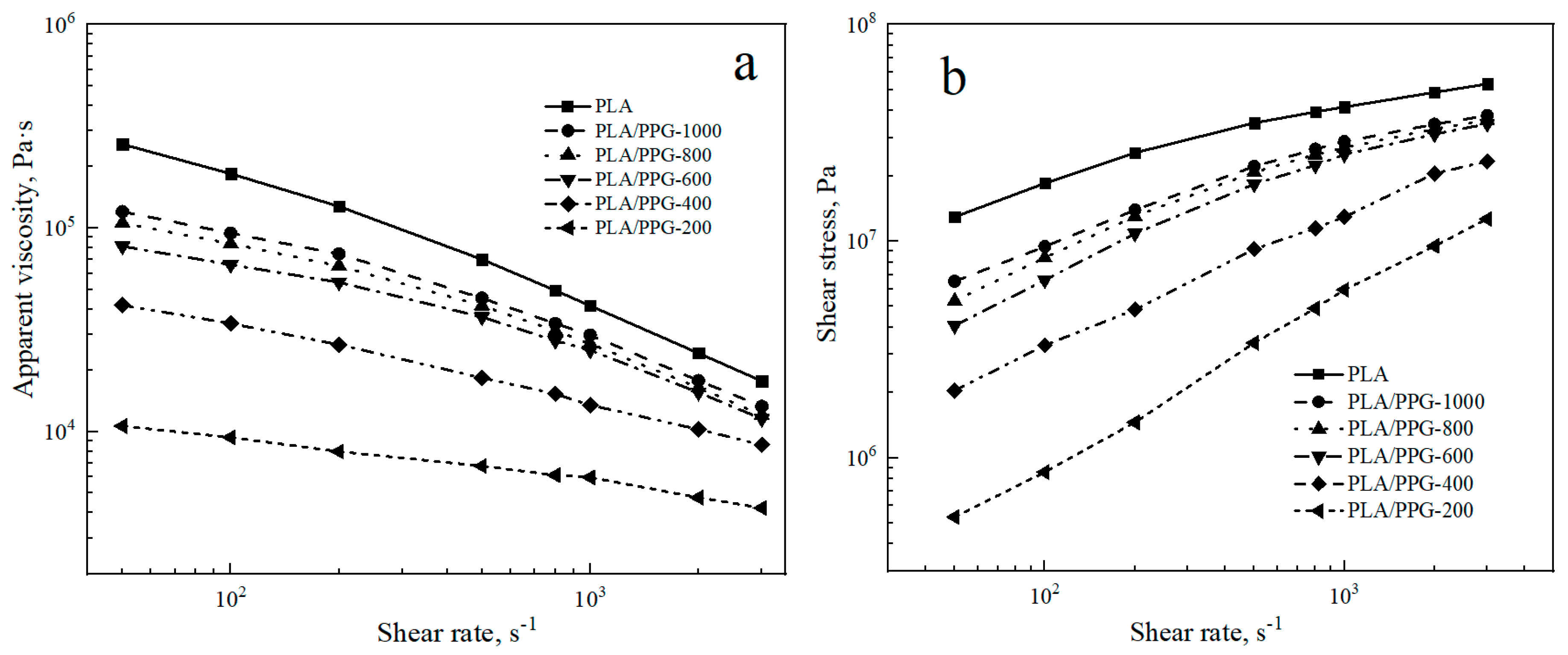
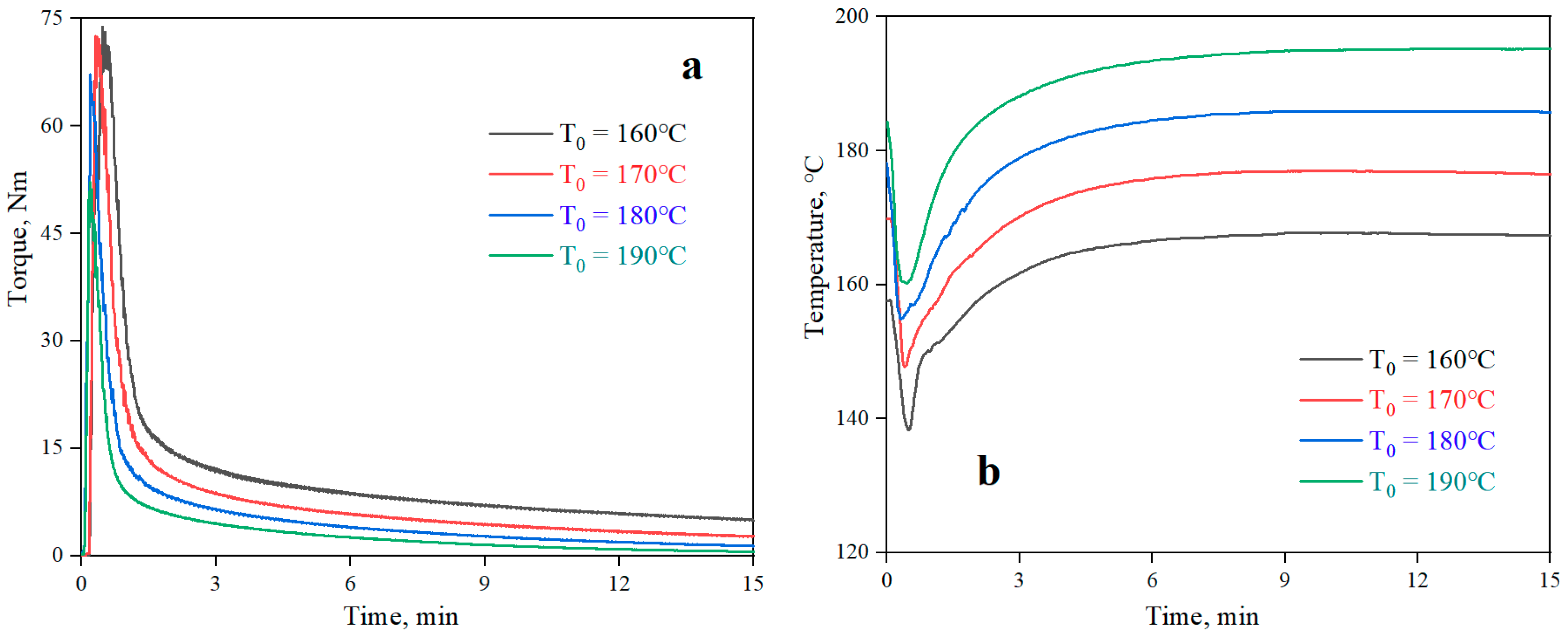
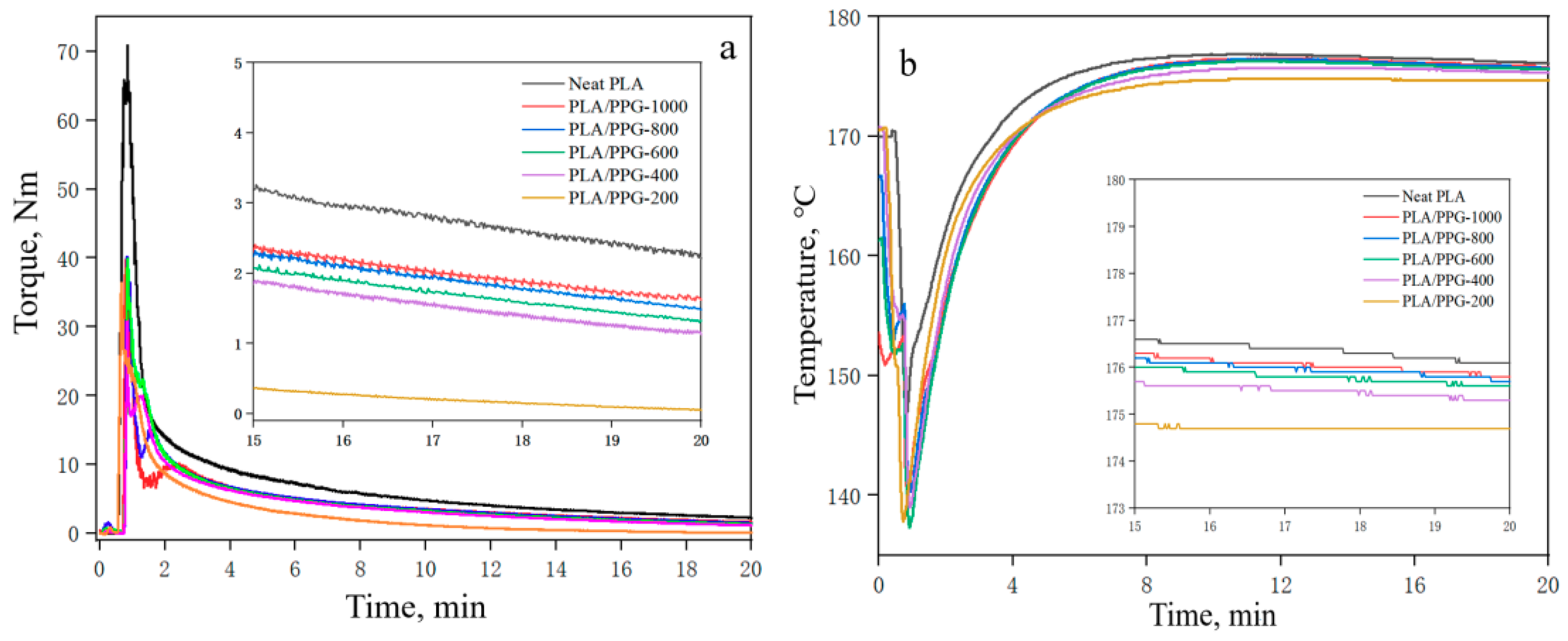
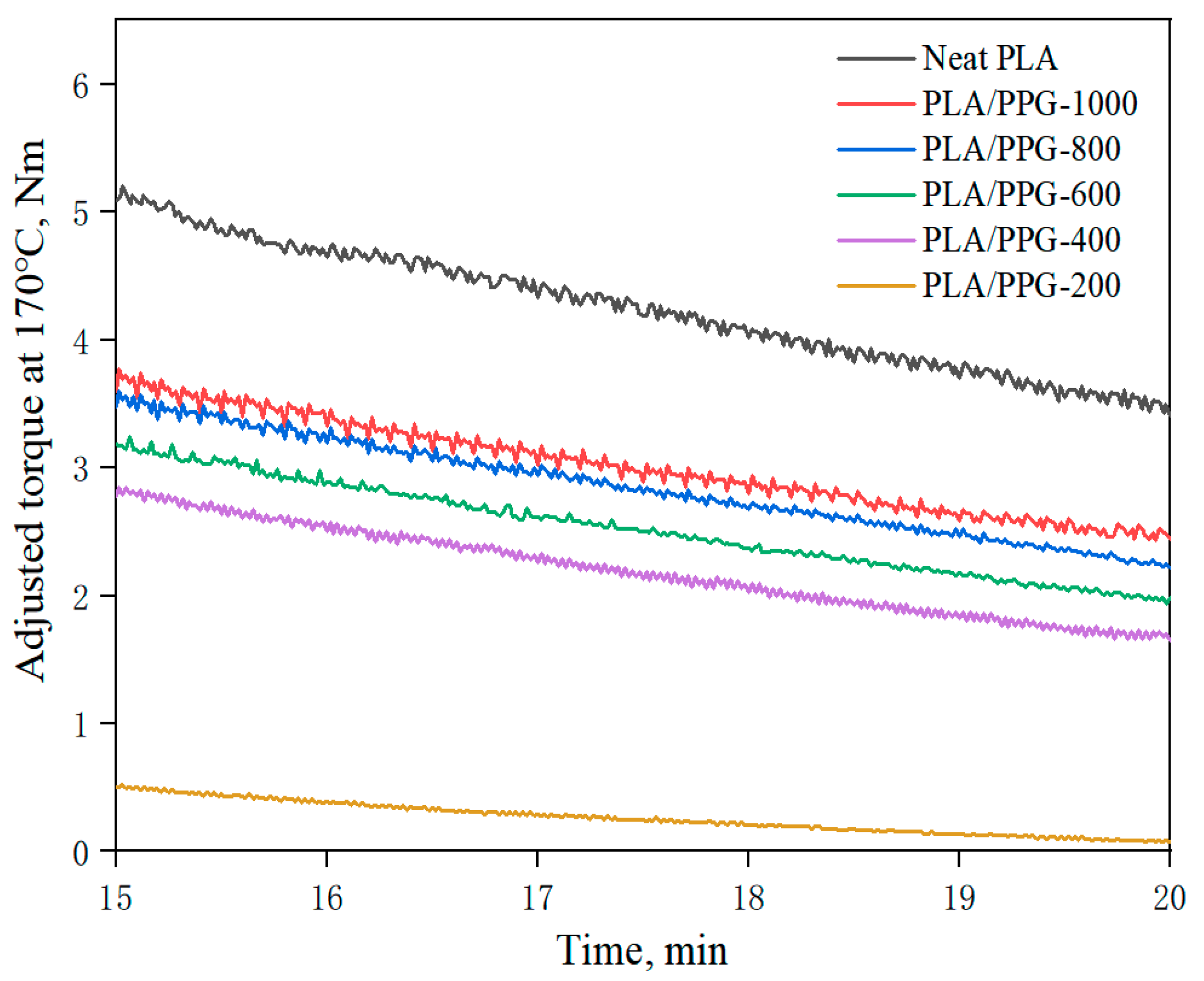
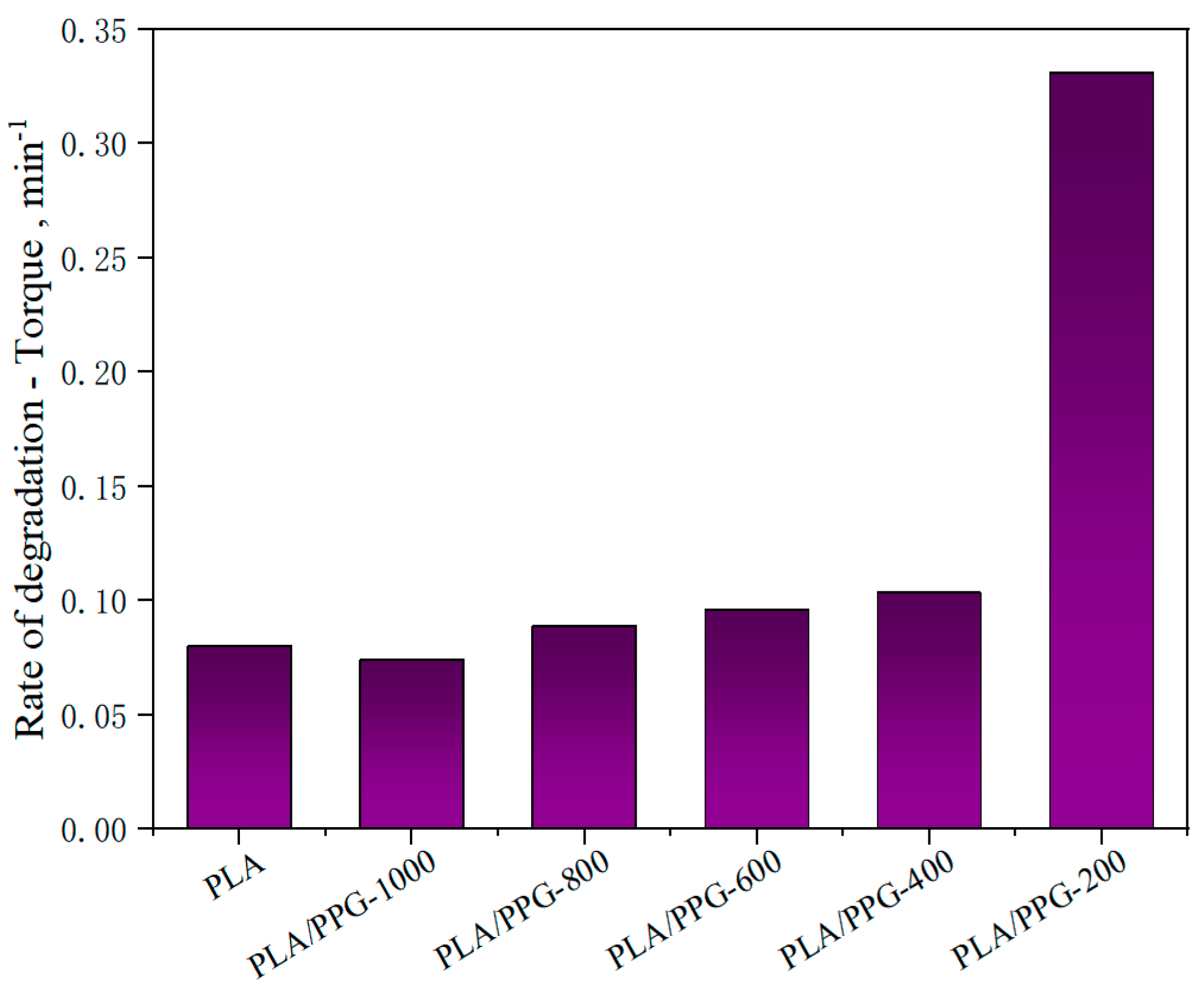
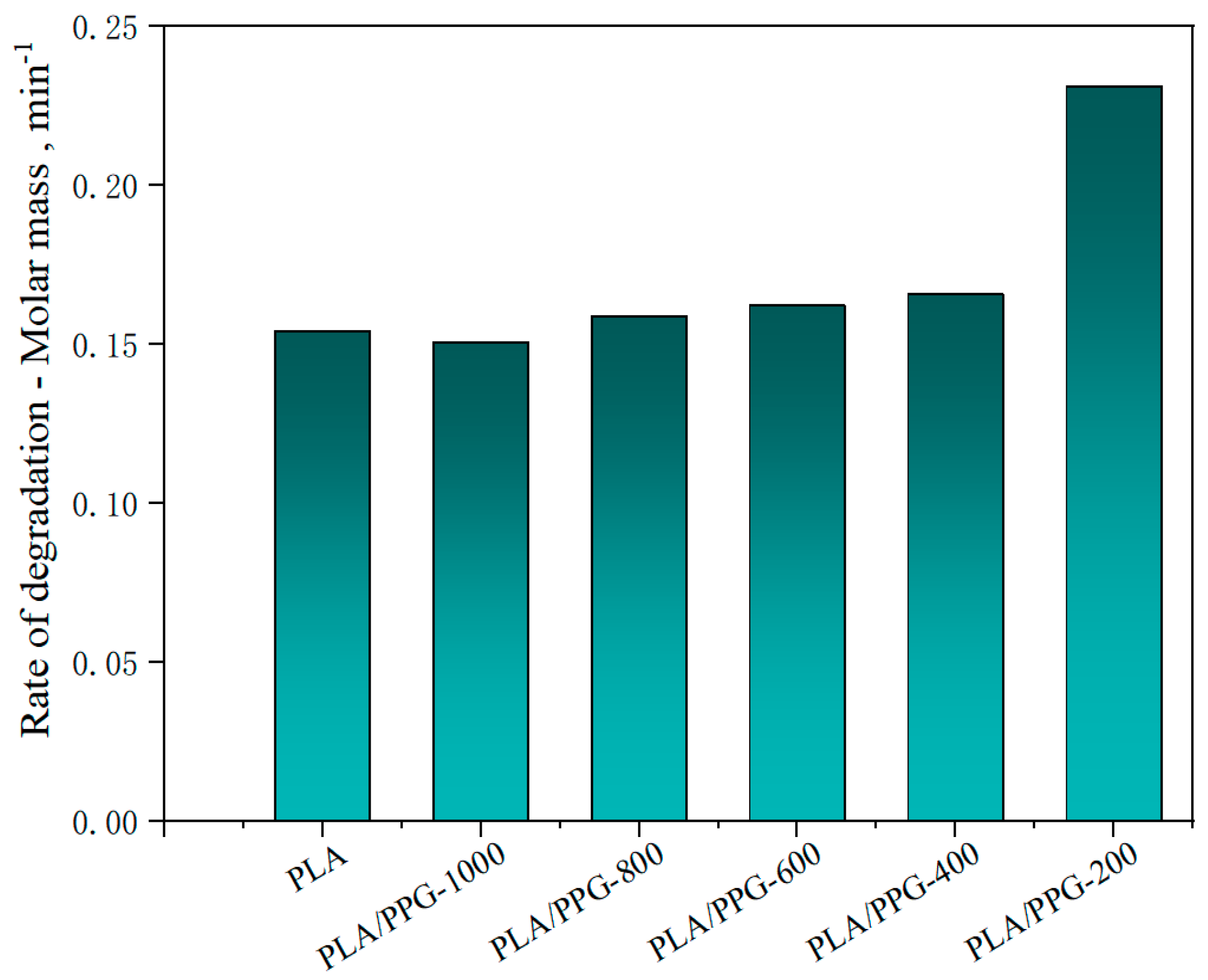
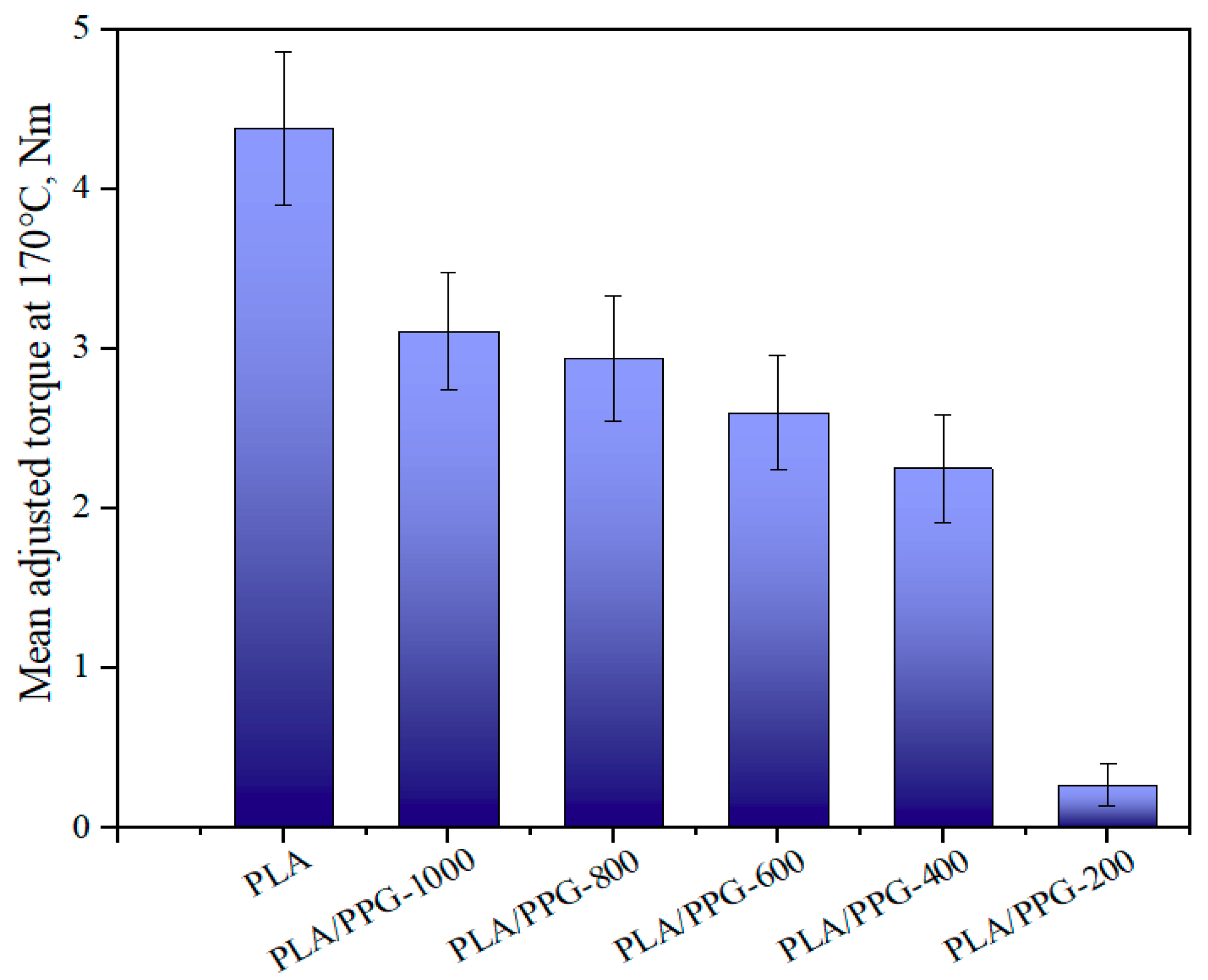

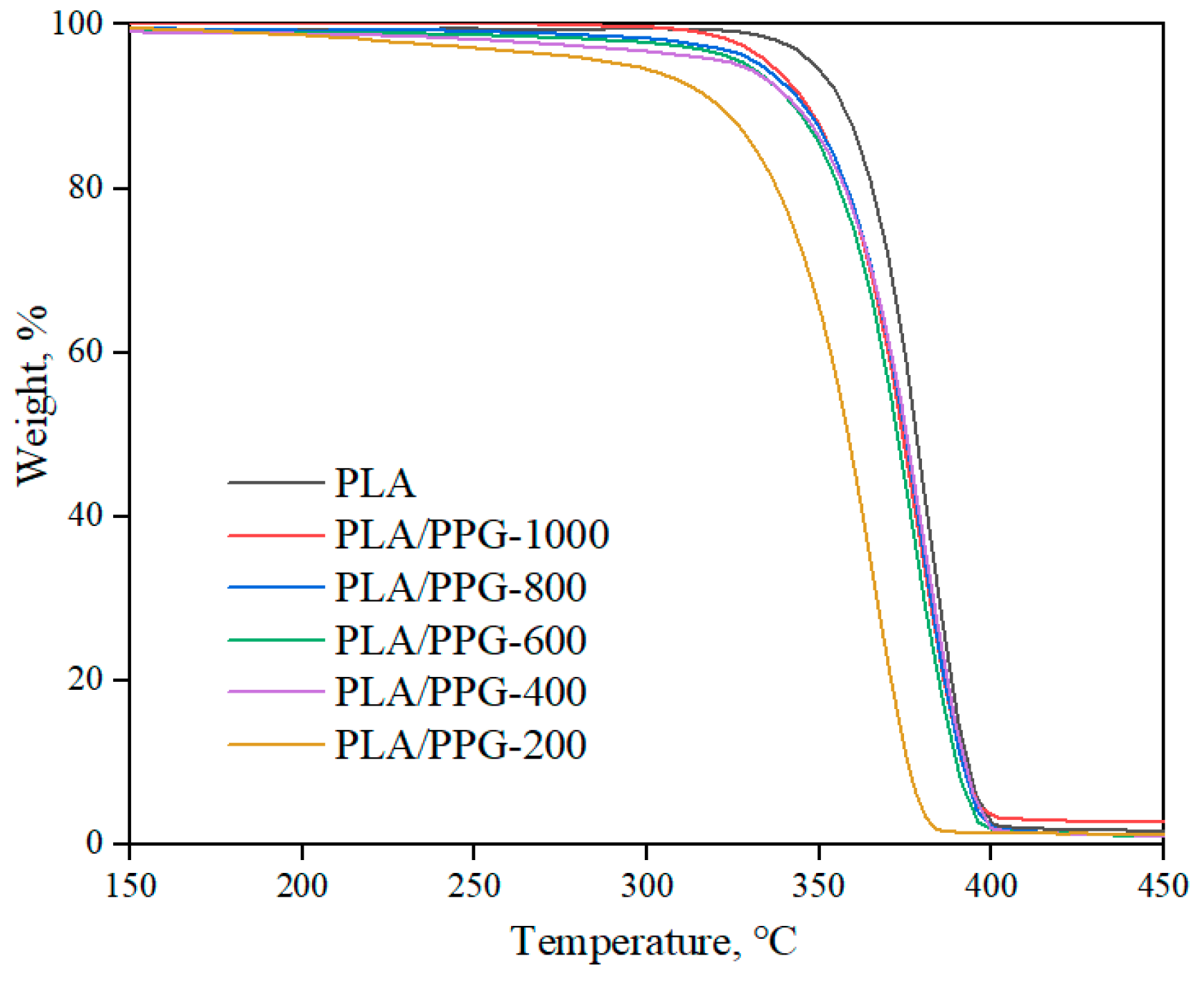
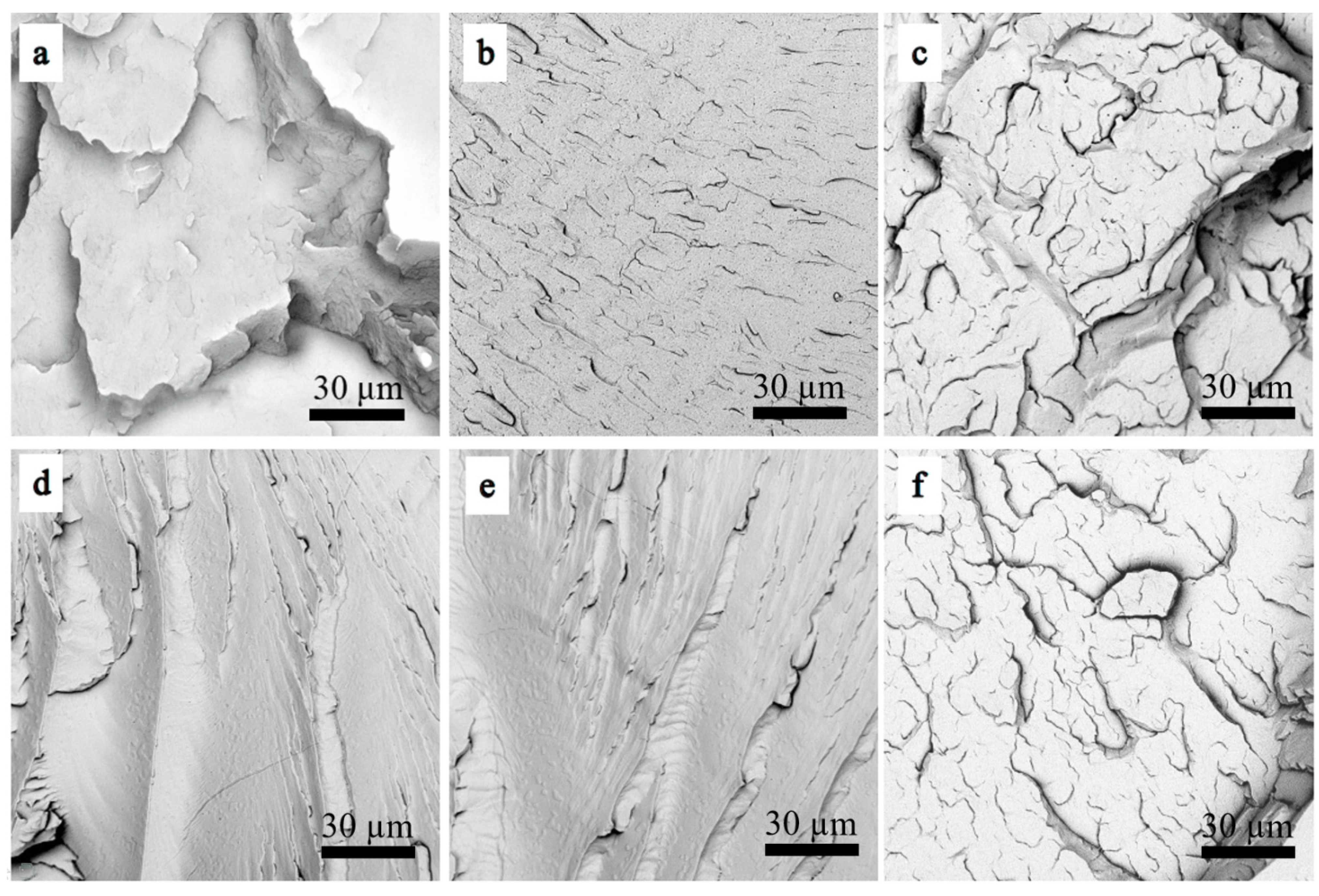
| /s−1 | n | |||||
|---|---|---|---|---|---|---|
| PLA | PLA/PPG-1000 | PLA/PPG-800 | PLA/PPG-600 | PLA/PPG-400 | PLA/PPG-200 | |
| 50 | 0.504 | 0.701 | 0.701 | 0.785 | 0.610 | ~1.000 |
| 100 | 0.428 | 0.596 | 0.596 | 0.667 | 0.518 | ~1.000 |
| 200 | 0.372 | 0.518 | 0.518 | 0.580 | 0.451 | 0.889 |
| 500 | 0.317 | 0.441 | 0.442 | 0.494 | 0.384 | 0.758 |
| 800 | 0.295 | 0.410 | 0.410 | 0.460 | 0.357 | 0.704 |
| 1000 | 0.286 | 0.397 | 0.397 | 0.445 | 0.346 | 0.682 |
| 2000 | 0.259 | 0.361 | 0.361 | 0.404 | 0.314 | 0.620 |
| 3000 | 0.246 | 0.343 | 0.343 | 0.384 | 0.298 | 0.588 |
| Sample | RZ/min−1 | RM/min−1 | ||
|---|---|---|---|---|
| PLA | 2.70 ± 0.27 | 4.38 ± 0.48 | 0.0801 | 0.1540 |
| PLA/PPG-1000 | 1.96 ± 0.22 | 3.11 ± 0.37 | 0.0739 | 0.1505 |
| PLA/PPG-800 | 1.87 ± 0.23 | 2.94 ± 0.39 | 0.0888 | 0.1586 |
| PLA/PPG-600 | 1.67 ± 0.22 | 2.60 ± 0.36 | 0.0959 | 0.1621 |
| PLA/PPG-400 | 1.48 ± 0.22 | 2.25 ± 0.34 | 0.1033 | 0.1656 |
| PLA/PPG-200 | 0.19 ± 0.09 | 0.27 ± 0.13 | 0.3311 | 0.2310 |
| Sample | Tg/°C | Tcc/°C | Tm1/°C | Tm2/°C |
|---|---|---|---|---|
| PLA | 58.5 | 124.5 | 150.5 | - |
| PLA/PPG-1000 | 49.5 | 108.5 | 145.5 | 153.0 |
| PLA/PPG-800 | 49.0 | 108.5 | 145.5 | 152.5 |
| PLA/PPG-600 | 48.5 | 107.5 | 145.0 | 152.5 |
| PLA/PPG-400 | 48.0 | 104.5 | 144.0 | 151.5 |
| PLA/PPG-200 | 48.0 | 103.5 | 142.5 | 151.5 |
© 2019 by the authors. Licensee MDPI, Basel, Switzerland. This article is an open access article distributed under the terms and conditions of the Creative Commons Attribution (CC BY) license (http://creativecommons.org/licenses/by/4.0/).
Share and Cite
Xie, D.; Zhao, Y.; Li, Y.; LaChance, A.M.; Lai, J.; Sun, L.; Chen, J. Rheological, Thermal, and Degradation Properties of PLA/PPG Blends. Materials 2019, 12, 3519. https://doi.org/10.3390/ma12213519
Xie D, Zhao Y, Li Y, LaChance AM, Lai J, Sun L, Chen J. Rheological, Thermal, and Degradation Properties of PLA/PPG Blends. Materials. 2019; 12(21):3519. https://doi.org/10.3390/ma12213519
Chicago/Turabian StyleXie, Dong, Yang Zhao, Yuan Li, Anna Marie LaChance, Jinqing Lai, Luyi Sun, and Junjia Chen. 2019. "Rheological, Thermal, and Degradation Properties of PLA/PPG Blends" Materials 12, no. 21: 3519. https://doi.org/10.3390/ma12213519
APA StyleXie, D., Zhao, Y., Li, Y., LaChance, A. M., Lai, J., Sun, L., & Chen, J. (2019). Rheological, Thermal, and Degradation Properties of PLA/PPG Blends. Materials, 12(21), 3519. https://doi.org/10.3390/ma12213519






